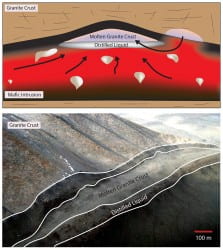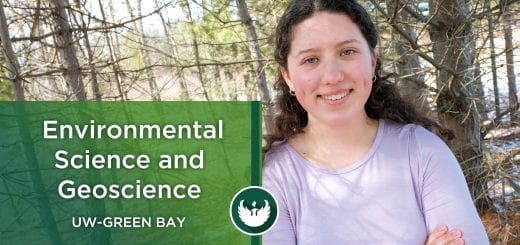Studying a rock and a hard place: Ancient magmas in Antarctica at the core of Yagle’s research
UW-Green Bay Environmental Science and Policy graduate Brian Yagle ’16 did his graduate work in the “Frozen Tundra” of Green Bay, Wis. Ironic then, that he studied a true frozen tundra, thousands of miles away, in the McMurdo Dry Valleys of Antarctica.
Yagle has never set foot in the barren oasis, but that hasn’t prevented him from digging deep into the volcanic desert, particularly the geology and the magma-mixing process, which is at the core of his master’s research.
Although mostly covered by snow and ice, Antarctica has an ancient history of volcanism. “To me, magma (molten rock) is pretty darn interesting,” Yagle says. “Understanding the magma-mixing processes is important because of the potential these processes have in initiating volcanic eruptions, and also in generating economic ores,” Yagle explains. “Igneous intrusions, similar to the one I am studying in Antarctica, have been linked to petroleum and ore deposits.”
But why Antarctica? About 180 million years old, Antarctica would have been incredibly volcanic, according to Yagle’s research mentor Prof. Ryan Currier. Huge volumes of magma were being generated and coursing through the crust, driven by the breakup of Gondwana (the supercontinent consisting of Africa, South America, Antarctica, India and Australia). Because of erosion and how the layers of rock are gently tilted, the McMurdo Dry Valleys offer a unique view of a magmatic plumbing system that can be traced from erupted lavas all the way down to about 3.5 km depth — near the field site being studied by Yagle.
Additionally, according to Yagle, the harsh, dry conditions within the Valleys have provided a landscape where snow doesn’t accumulate and soil doesn’t form, leaving an unobstructed view to the region’s magmatic plumbing system.
“It’s the perfect scientific observatory,” says Yagle. In search of a challenge for his thesis, Yagle approached Prof. Currier about this particular project. Currier worked there during his own graduate school experience, and brought back samples for further study.
“Understanding the processes of magma-mixing appealed to me and because it was an area of research that Dr. Currier had experience in and seemed to enjoy.”
“Magma is molten rock,” said Currier. “It’s a loose definition, because compositionally, magmas can be very diverse. When two different magmas come into contact with one another, there is the potential for magma-mixing.”
At the core of Yagle’s research was the discovery of how magma-mixing works by studying his field site, where multiple magmas collided, partially mixed, and solidified.
“Brian’s system of study is a neat one,” said Currier. “A 450 meter thick magmatic intrusion melted some of the surrounding crust, and then incorporated it. Then, a separate magma that formed from distillation-like processes formed inside of the intrusion. The result is a tiered magma body, each organized by density, with limited amounts of mixing occurring between each.”
Yagle analyzed the chemistry and isotopes of 13 samples Currier brought back from his trip. And then it was a matter of a lot of microscope work and mathematical modeling. As with most UWGB-student research, Yagle received guidance from his faculty mentor to move through the project from start to completion in summer of 2016.
“With his help I was able to use the samples he collected to estimate the temperatures the two magmas were at when they were emplaced, the time it took the magmas to cool, and the amount of mixing that occurred.
“Brian discovered some really interesting phenomena in this magma-mingling system,” said Currier. “Mixing was limited in scope. Some samples appear to show clear chemical signs of mixing, but most samples show no signs of mixing. Mixing was really inefficient, at least in this system. The density stratified aspect of the magmas may be the only one ever observed in Nature.”
Prof. Currier said it has been a refreshing opportunity to re-experience Antarctica and to share in the excitement of learning from a truly unique environment with Brian.
“Brian was a model graduate student,” he said. “He is by nature an extremely diligent worker, not just towards completing the task at hand, but also towards a deeper understanding as well. Magmas are complex, dirty, difficult to model substances,” Currier said. “From my perspective, Brian has made this project an absolute pleasure for me.”
Yagle, who has an internship with the Army Corps of Engineers while completing his master’s degree work, will soon begin work for its St. Paul, Minn. regulatory division. His job will be to enforce the Clean Water Act and the Rivers and Harbors Act.
“I will be shifting my studies from igneous petrology to wetlands,” Yagle says. “I am excited to tackle a new field of study, however, I really enjoyed my project with Dr. Currier. It completely changed the way I look at the world.” And in the distant future Yagle has an aspiration that requires completion.
“It is a dream of mine to go to Antarctica. It really is one of the final frontiers on Earth. I would jump at a chance to go there.”
Note: This is an update to the original story about Yagle’s research published in the Spring 2016 Inside magazine. Illustrations by Prof. Ryan Currier. Photos by Dan Moore.





